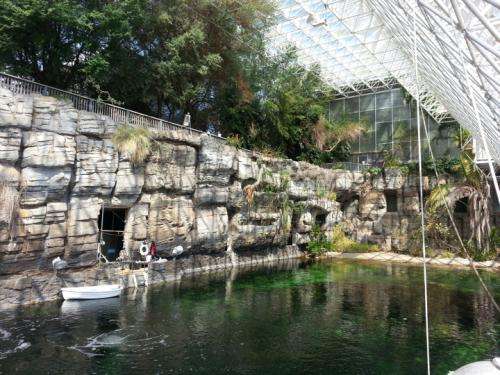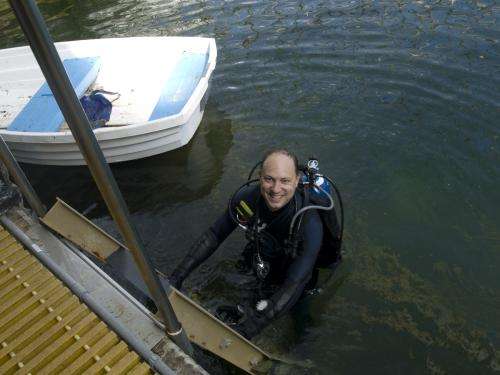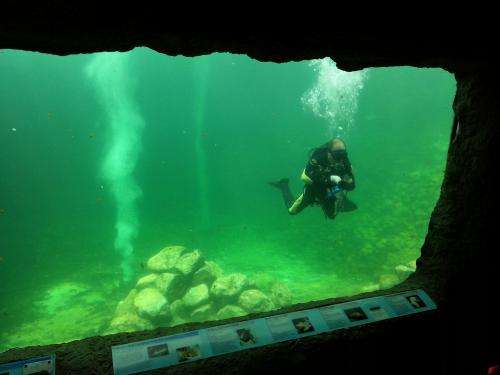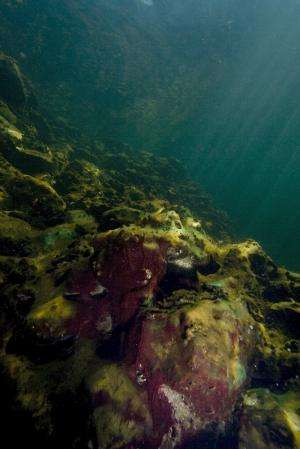A new ocean for the desert

As I let the air out of my buoyancy vest and slip under the water of the University of Arizona's Biosphere 2 ocean, I hear a steady hum reminding me of the machinery working behind the scenes to filter the water and keep it a constant temperature of 74 degrees.
Below me, pale, dead coral heads emerge from the brown carpet of muck blanketing the bottom of this strange ocean. At 22 feet, I reach the sandy bottom. Behind a large acrylic window, people wave at me as I kick my fins and glide past them.
On the other side of the window, in Biosphere 2's Ocean Gallery, visitors peer into the murky green of what was once the only living coral reef in the Arizona desert. Enclosed under the huge greenhouse structure that is part of Biosphere 2, the "ocean" was one of several habitats intended to sustain a crew of scientists living and working inside the dome isolated from the outside world.
When the "enclosed missions" ended in 1994, the fragile ecology of the ocean habitat collapsed. The corals died and algae and bacterial mats took over, crowding out the reef.
Marine life under glass: The Desert Sea
Now, a new initiative is underway to breathe life back into the 700,000-gallon ocean tank at Biosphere 2. But rather than re-creating a tropical coral reef modeled after what one would find diving in the Caribbean, the new ocean at Biosphere 2 will provide a glimpse into the sea that's closest to Southern Arizona – the Gulf of California, which stretches for a thousand miles from the mouth of the Colorado River to Mazatlan on the mainland of Mexico.
"We are excited to share the story behind the Gulf of California, which makes this beautiful desert around us one of the world's most biologically diverse deserts," said Rafe Sagarin, the program manager in the UA College of Science who oversees the transformation of the Biosphere 2 ocean habitat. His vision is turning it into a living laboratory where schoolchildren and the public can learn about the many connections between the Gulf of California and the Sonoran Desert.
To make the new ocean a reality, Sagarin organized a workshop at the beginning of March, inviting a group that includes educators, aquarium experts, scientists and myself – something I have been very excited to be a part of, as my own travels have taken me to the Sea of Cortez and the desert around it during many explorations underwater and on land.

Our goal with this workshop is to move from dreamy ideas – big and small – gathered during a previous meeting, to workable ideas that can be illustrated and planned out going forward. For example, the group reached a conclusion that it would be better to drain the ocean habitat completely and remodel it rather than attempting to make changes with the water in place. This strategy might open up further research and education opportunities at Biosphere 2, with sustainable aquaculture facilities as one of the possibilities.
Reimagining an ocean
Of all the world's deserts, the Sonoran Desert stands out with its unparalleled richness and diversity of plants and animals. Yet, few realize that this diversity is in large part due to the presence of a sea just south of Arizona.
Without the Gulf of California, there would be no monsoon clouds bringing the rains to the parched desert in the summer months, Sagarin explained.
"Southern Arizona would look much different, were it not for the various species of animals and plants and the peoples and cultures that have moved between the gulf coast and the desert for thousands of years."
"We have this incredible ocean space that has been used for some great research, but is currently not being used to its full potential," Sagarin said. "We believe it could be better used for research, education and outreach all at once. So why not use it for what is relevant to this region?"
Sea turtles and giant squid
The new ocean will feature a rocky intertidal zone hugging a sandy beach, an underwater forest and a cactus-studded island. A variety of fishes, octopus, moray eels, stingrays, and possibly even sea turtles and giant squid may soon live in Arizona's only desert ocean.

The opportunity will allow marine scientists to perform experiments that would not be feasible in a real ocean. It also will foster education efforts so schoolchildren can learn about marine environments and visitors can discover important connections between the sea and the desert.
"True to Biosphere 2's mission of being a one-of-a-kind facility 'where science lives,' we will share this project with the public while it is in progress," Sagarin said.
A remodeled Ocean Gallery has just opened to the public, explaining the connection between the Sonoran Desert and the Gulf of California, following the exploits of past explorers, and laying out the plans for the finished "mini ocean."
Sagarin and his collaborators are looking at a wide range of funding options to provide support for the ambitious endeavor, including the National Science Foundation, nongovernmental organizations and foundations that have funded research and conservation projects in the gulf.

To get the project off the ground, Sagarin has launched a crowd funding campaign on Rockethub, with the purpose of not only raising funds, but awareness as well. This is the first time the University has officially sanctioned crowdfunding for a scientific project.
"Ultimately, we hope to get individual donors excited about a really big science project that cannot be done anywhere else because there is no other facility in the world where you could do something like this," Sagarin said.
"It's a big audacious project," he added. "But this is exactly what Biosphere 2 was built to do and continues to do: address big environmental challenges."
Provided by University of Arizona



















